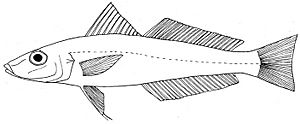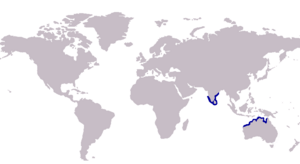Mud whiting facts for kids
Quick facts for kids Mud whiting |
|
|---|---|
 |
|
| Scientific classification | |
 |
|
| Range of the mud whiting | |
| Synonyms | |
|
The mud whiting, Sillago lutea, is a type of fish that lives in the coastal parts of the ocean. It belongs to the smelt-whiting family, called Sillaginidae. Scientists first described the mud whiting in 1985. Today, we know it lives off the northwest coast of Australia and along the coast of India.
As its name suggests, mud whitings like to live in muddy or silty places. They are often found near banana prawns. Because of this, fishing boats that catch prawns in Australia also catch many mud whitings. However, people don't usually sell this fish in the market.
Contents
About the Mud Whiting's Name
The mud whiting is one of 29 different types of fish in the group called Sillago. This group is part of the smelt-whiting family, Sillaginidae.
Scientists Dutt and Sujatha first studied this fish in India. They thought it was already a known species called Sillago macrolepis. But later, another scientist named Roland McKay looked at the fish again. He realized it was a new species and named it Sillago lutea. A fish found in Exmouth Gulf in Western Australia became the main example, or holotype, for this new species. The name "lutea" comes from a Latin word meaning "belonging to mud". This fits well with the fish's common name and its favorite muddy home.
What Does the Mud Whiting Look Like?
Like most fish in the Sillago group, the mud whiting has a body that is a bit flat and long. It gets thinner towards its mouth. Its body is covered in small scales. It also has two rows of scales on its cheeks and head.
The mud whiting has two dorsal fins on its back. The first dorsal fin has 11 stiff spines. The second dorsal fin has 1 spine and then 20 to 22 soft rays. Its anal fin (on its underside) is similar, with 2 spines and 21 to 23 soft rays. Other ways to tell it apart include 67 to 72 scales along its lateral line and a total of 33 to 35 vertebrae (backbones). The biggest mud whiting ever found was over 16 centimeters long.
The fish's swim bladder helps it float. It has a short part in the front center and two parts that stick out to the front and sides. It also has one part that extends backward.
The mud whiting is a light sandy brown color on top. Its underside is a lighter brown or white. It has a faint silvery band along its side. Sometimes, the edges of its scales are a bit darker, making it look like a mesh pattern above the lateral line. All its fins are clear, except for the spiny dorsal fin, which has tiny black spots. Unlike some other whiting species, it does not have a dark spot at the base of its pectoral fin (the fin behind its gills).
Where the Mud Whiting Lives
The mud whiting lives in two main areas. One is the northwest coast of Australia, from Exmouth Gulf in Western Australia to the eastern Gulf of Carpentaria and the Arafura Sea. The other area is along the coasts of India and Sri Lanka.
Mud whitings are often found with banana prawns in northern Australia. They live in most muddy or very silty areas. You can find mud whitings in different water depths, from the surface down to 60 meters. These fish become ready to reproduce when they are about 10 centimeters long.
Mud Whiting and People
People usually catch mud whitings using trawl nets. Prawn trawlers catch a lot of them. However, because the fish only grows to about 16 centimeters, it is not very important for commercial fishing right now. Some smaller amounts are also caught by trawlers off the north coast of Australia. Scientists have suggested that this fish could be part of a small side-catch fishery, where they are exported without being cleaned.
See also
 In Spanish: Silago de barro para niños
In Spanish: Silago de barro para niños

